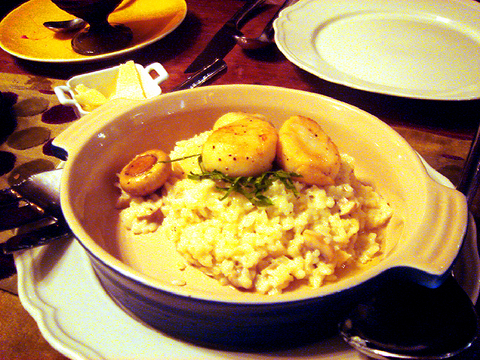The Taipei Times has twice reviewed VVG (Very Very Good) Bistro, of which VVG Table is a down-the-street offshoot. It was good then, and it remains good now. The original's cozy chaos contracts strongly with the design-conscious good-looks of the new joint.
The staff members, many of whom have studied in Europe, eschews a practice common to European-style restaurants in Taipei, which might generously be called "fusion." This is to say, instead of castrating their food to make it "conform to local taste," they spend considerable time and energy to do each dish properly.
In fact, be prepared to wait a bit for your food, because chances are that most of your order is going to be made from scratch. Past the semi-open porch and the rusticlassy wooden interior full of heavy wooden tables and an entire wall of wine, there is a beautiful open kitchen where you can see the chefs' heads bobbing over piles of fresh ingredients.

PHOTO: CHRIS PECHSTEDT, TAIPEI TIMES
The same thoughtfulness that goes into preparation and decoration goes into the menu. As I indiscreetly cast longing glances at my pumpkin soup (NT$180) and rocket salad with prosciutto, capsicum, and parmesan (NT$340), chef Vicky Huang (
The long prep-time for the main dishes makes it the sort of place where couples or larger groups with time to kill and money to burn can easily spend a long and comfortable summer evening.
Another big draw is the elaborate weekend brunch (NT$560, 11am to 4pm). This includes, but is not limited to, homemade bread, roast smoked salmon, chicken and zucchini skewers, and a dish described as "egg cups of crab and shrimp with quail egg and caviar." Cool drinks are served at strategic points through the meal, which ends with desert and cafe au lait or peppermint tea.
VVG Table is in a quiet maze of alleyways off the Zhongxiao-Dunhua intersection. It's not easy to find, but since it's made somewhat of a name for itself, most shopkeepers in the area should be able to provide directions.

On April 26, The Lancet published a letter from two doctors at Taichung-based China Medical University Hospital (CMUH) warning that “Taiwan’s Health Care System is on the Brink of Collapse.” The authors said that “Years of policy inaction and mismanagement of resources have led to the National Health Insurance system operating under unsustainable conditions.” The pushback was immediate. Errors in the paper were quickly identified and publicized, to discredit the authors (the hospital apologized). CNA reported that CMUH said the letter described Taiwan in 2021 as having 62 nurses per 10,000 people, when the correct number was 78 nurses per 10,000

As we live longer, our risk of cognitive impairment is increasing. How can we delay the onset of symptoms? Do we have to give up every indulgence or can small changes make a difference? We asked neurologists for tips on how to keep our brains healthy for life. TAKE CARE OF YOUR HEALTH “All of the sensible things that apply to bodily health apply to brain health,” says Suzanne O’Sullivan, a consultant in neurology at the National Hospital for Neurology and Neurosurgery in London, and the author of The Age of Diagnosis. “When you’re 20, you can get away with absolute

May 5 to May 11 What started out as friction between Taiwanese students at Taichung First High School and a Japanese head cook escalated dramatically over the first two weeks of May 1927. It began on April 30 when the cook’s wife knew that lotus starch used in that night’s dinner had rat feces in it, but failed to inform staff until the meal was already prepared. The students believed that her silence was intentional, and filed a complaint. The school’s Japanese administrators sided with the cook’s family, dismissing the students as troublemakers and clamping down on their freedoms — with

As Donald Trump’s executive order in March led to the shuttering of Voice of America (VOA) — the global broadcaster whose roots date back to the fight against Nazi propaganda — he quickly attracted support from figures not used to aligning themselves with any US administration. Trump had ordered the US Agency for Global Media, the federal agency that funds VOA and other groups promoting independent journalism overseas, to be “eliminated to the maximum extent consistent with applicable law.” The decision suddenly halted programming in 49 languages to more than 425 million people. In Moscow, Margarita Simonyan, the hardline editor-in-chief of the